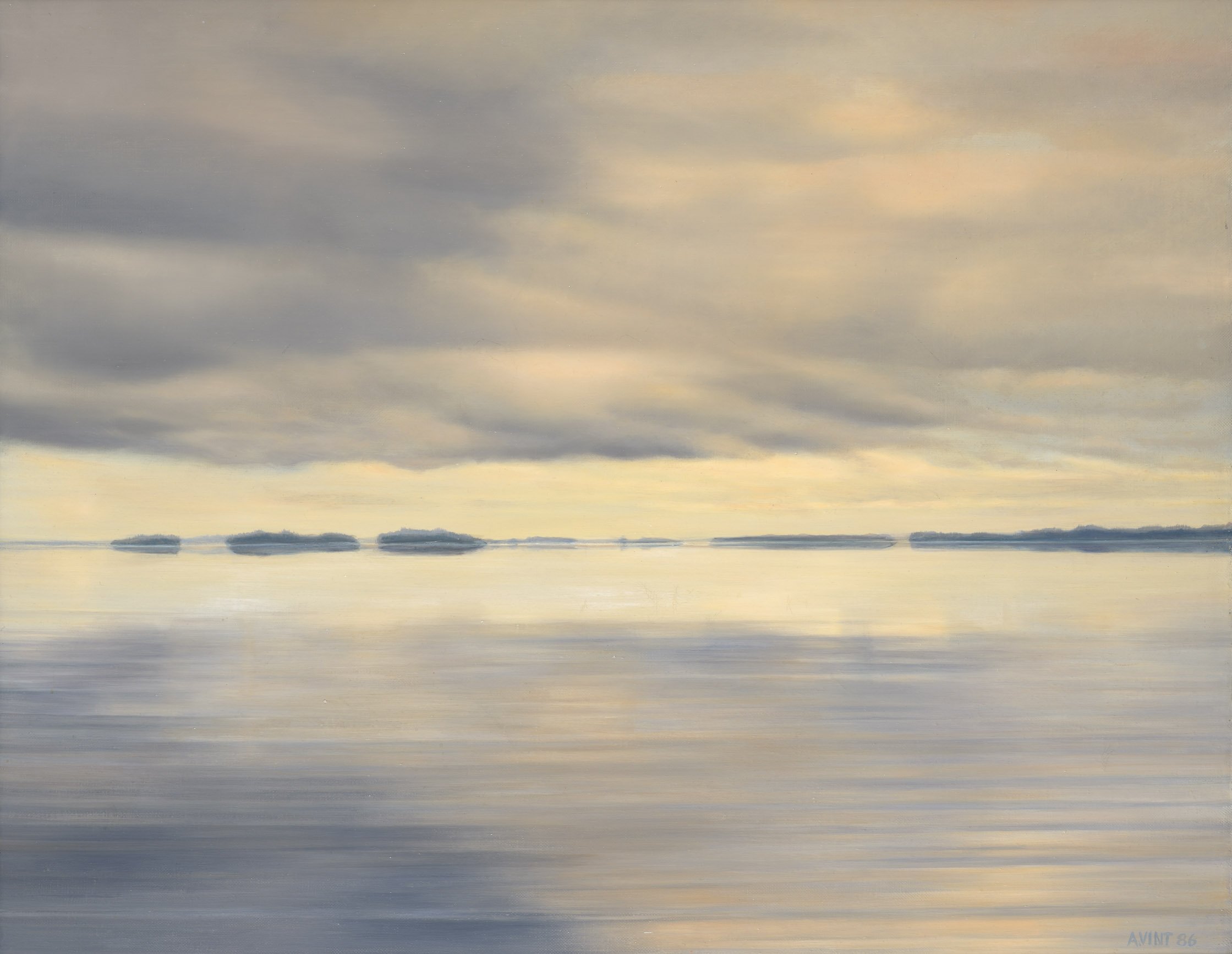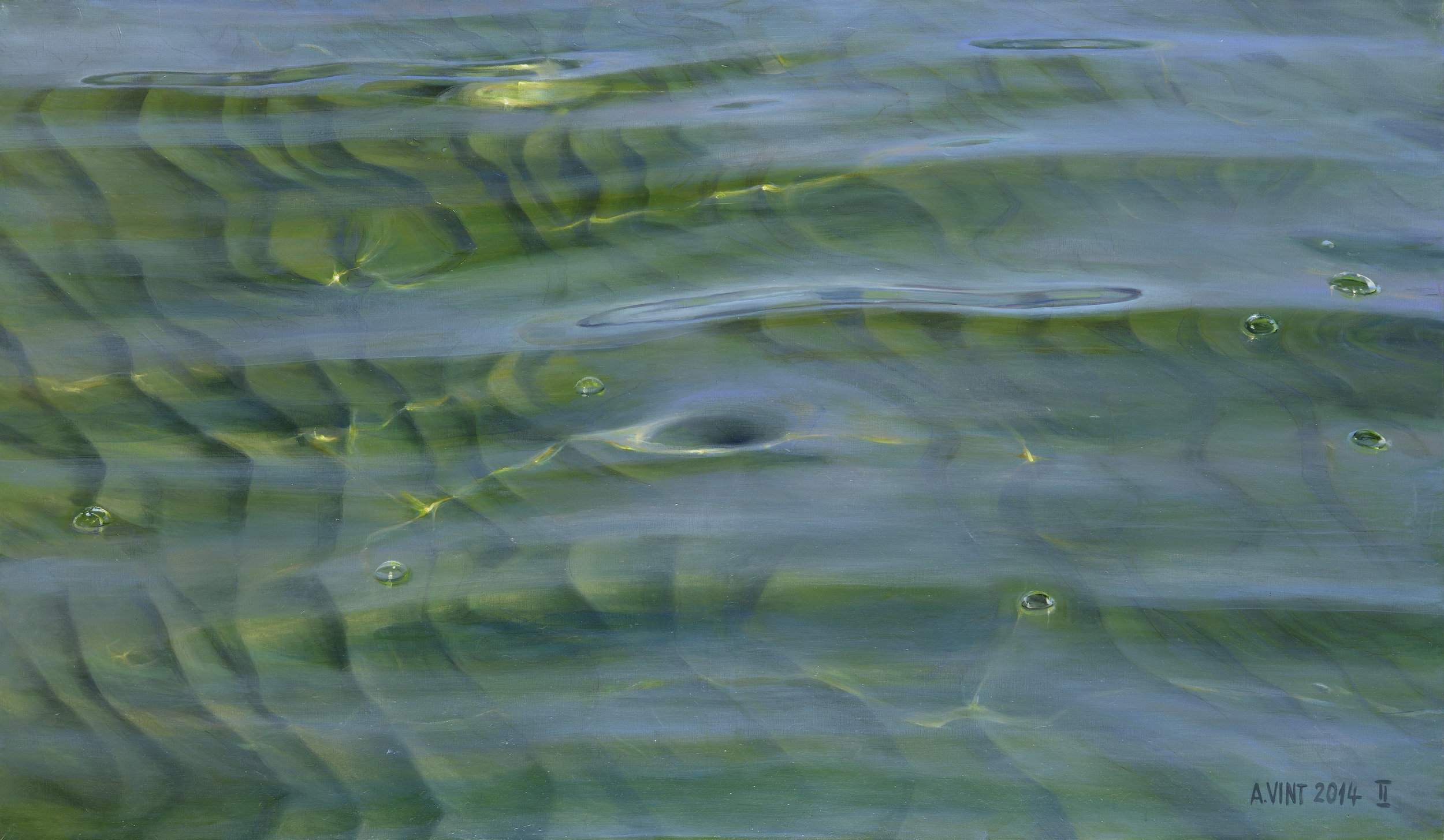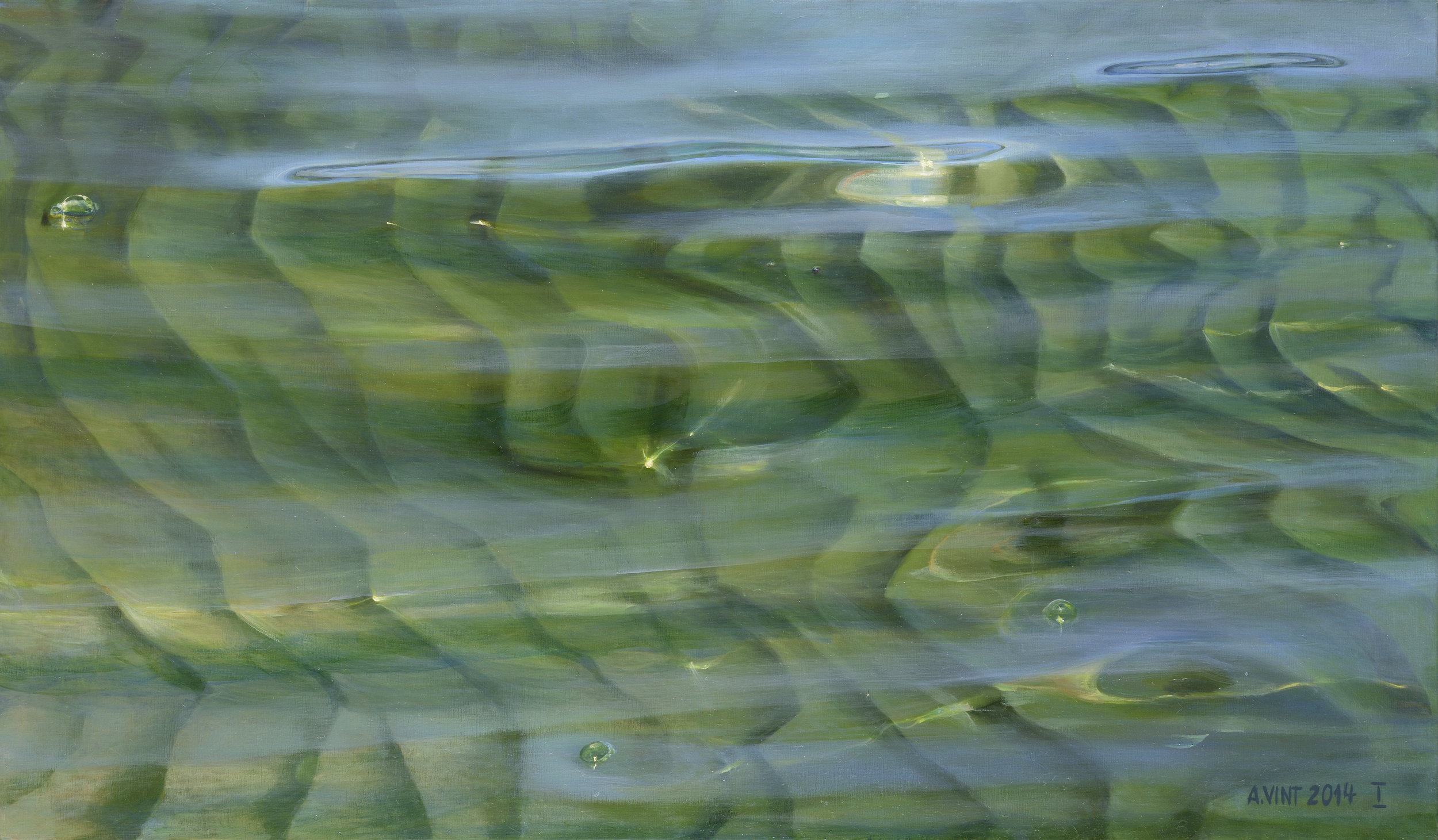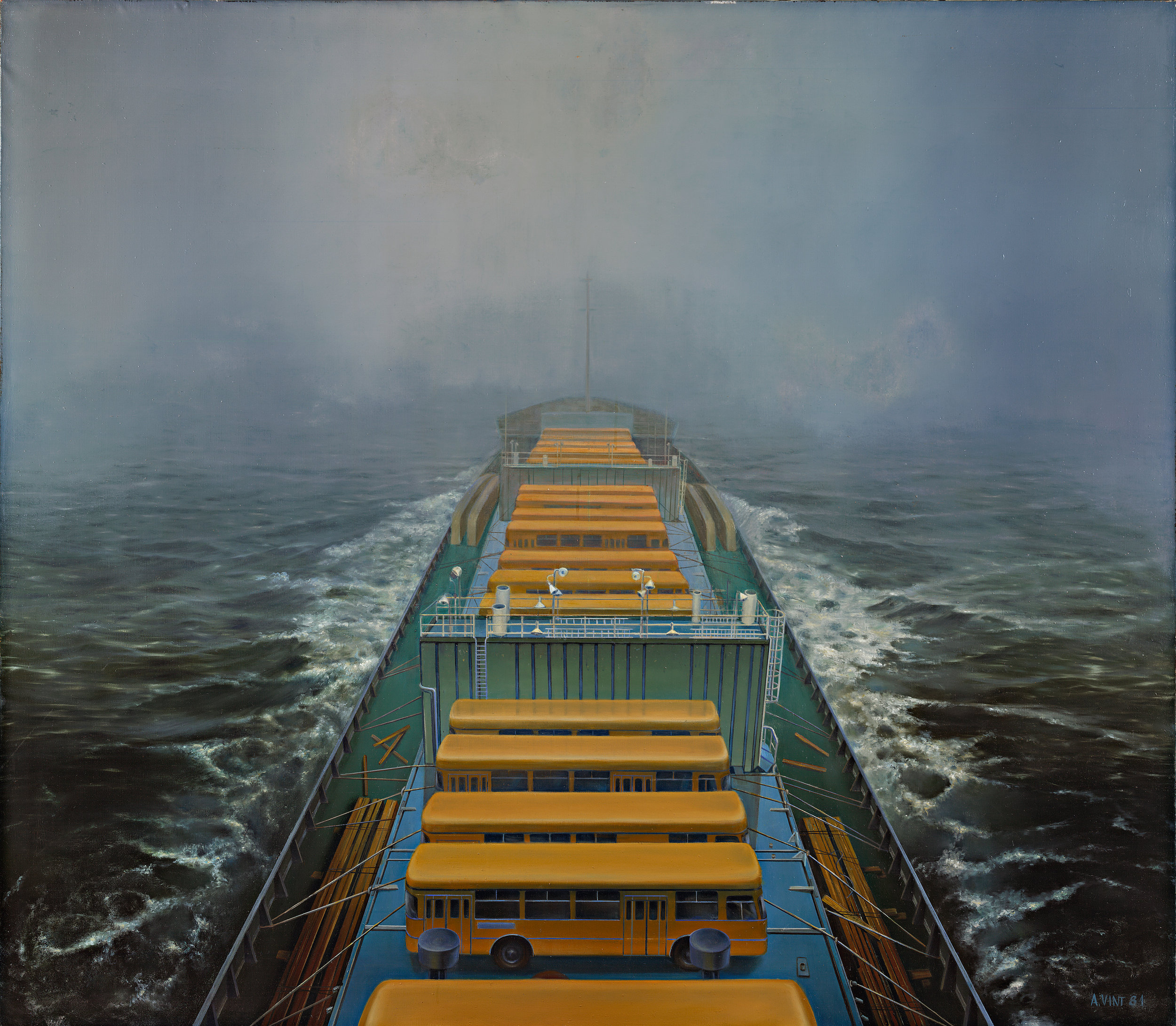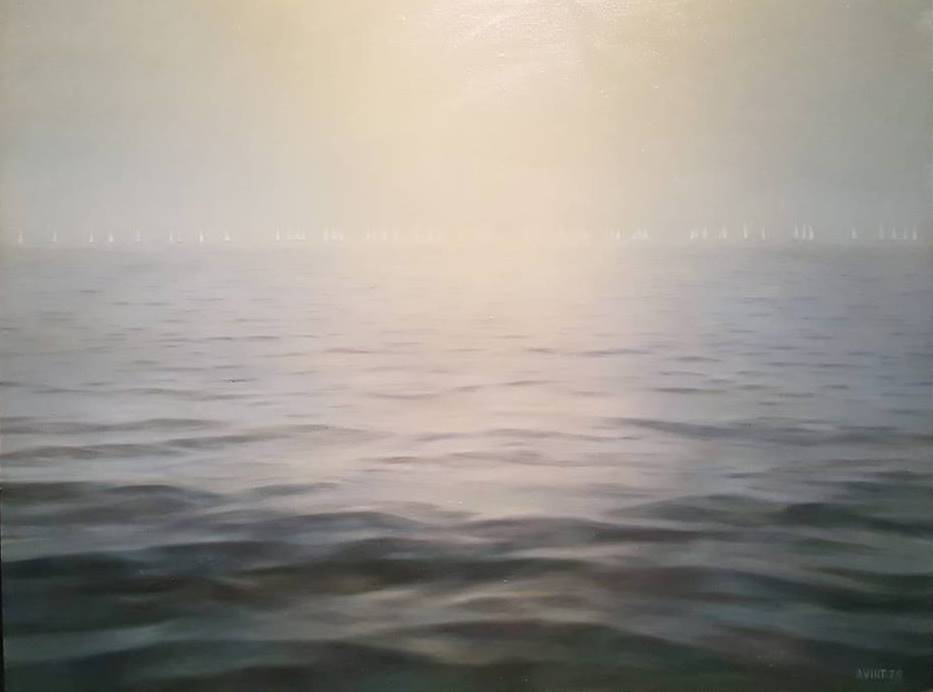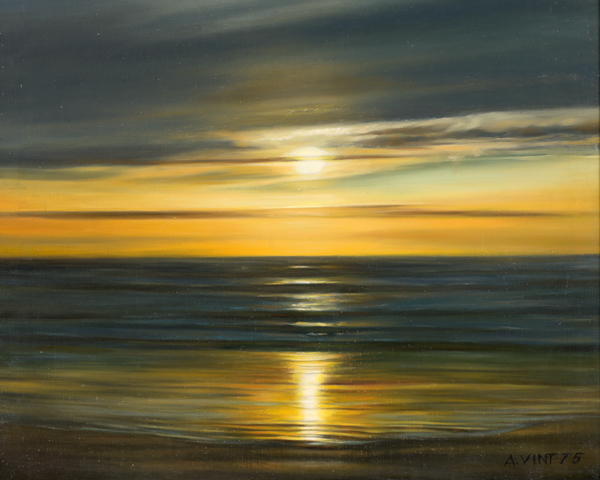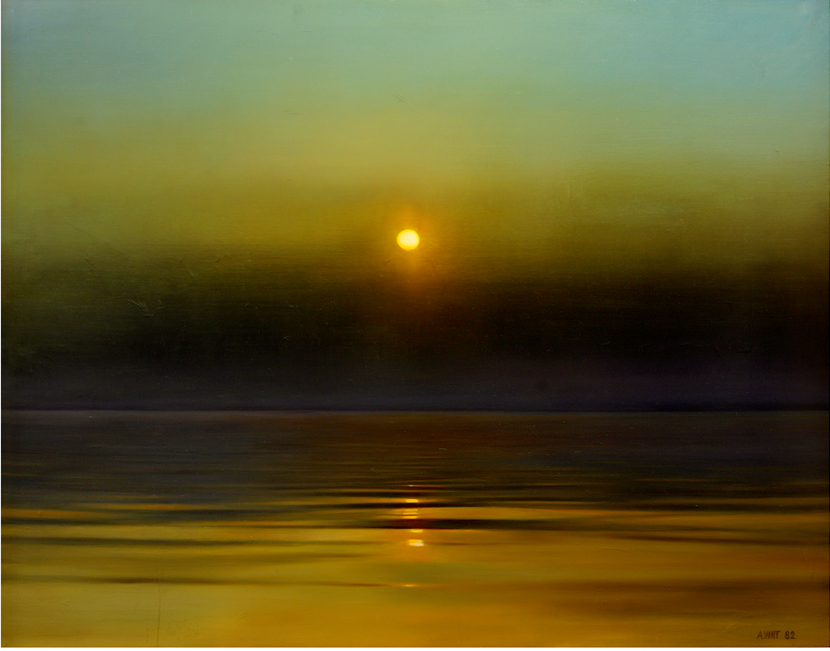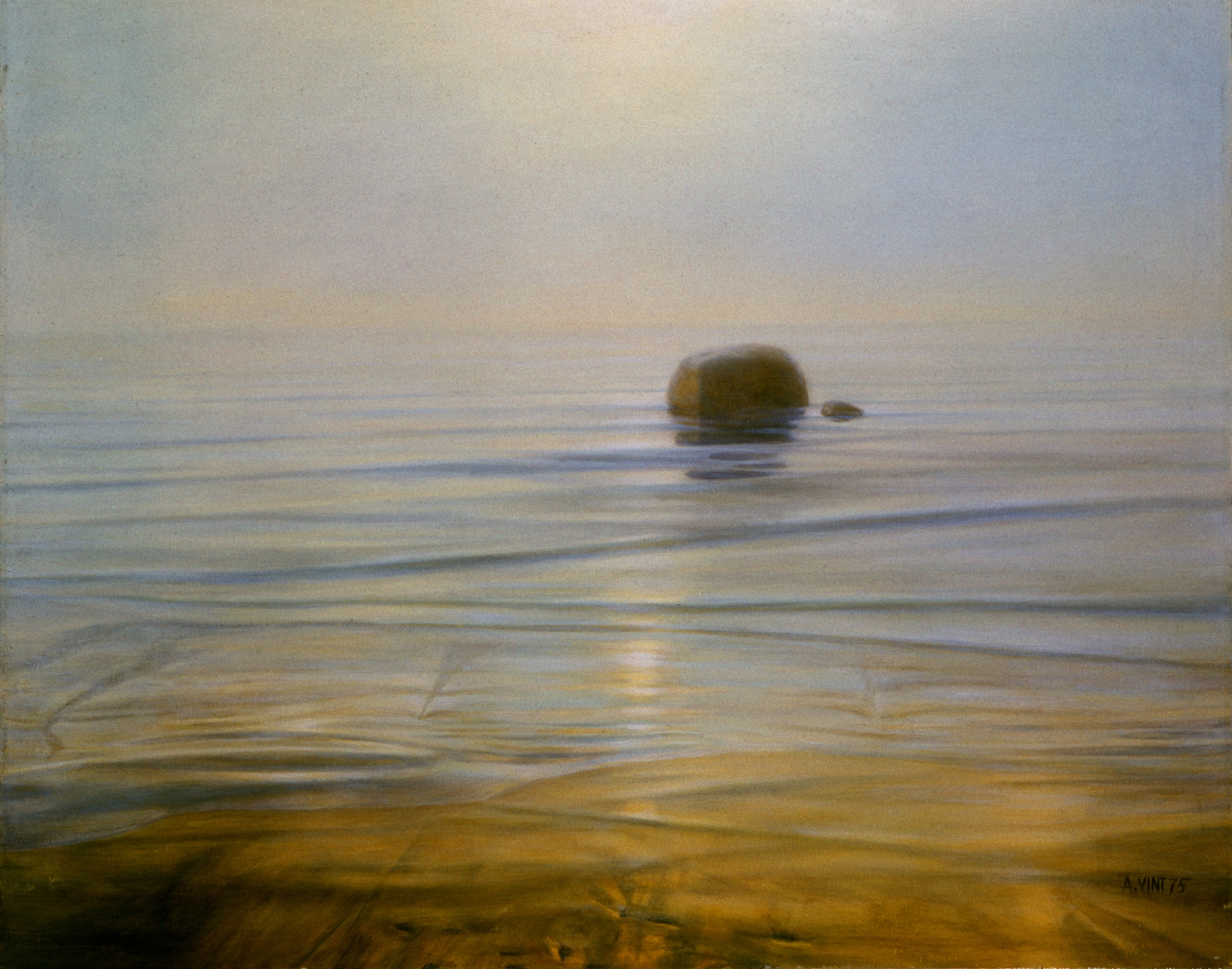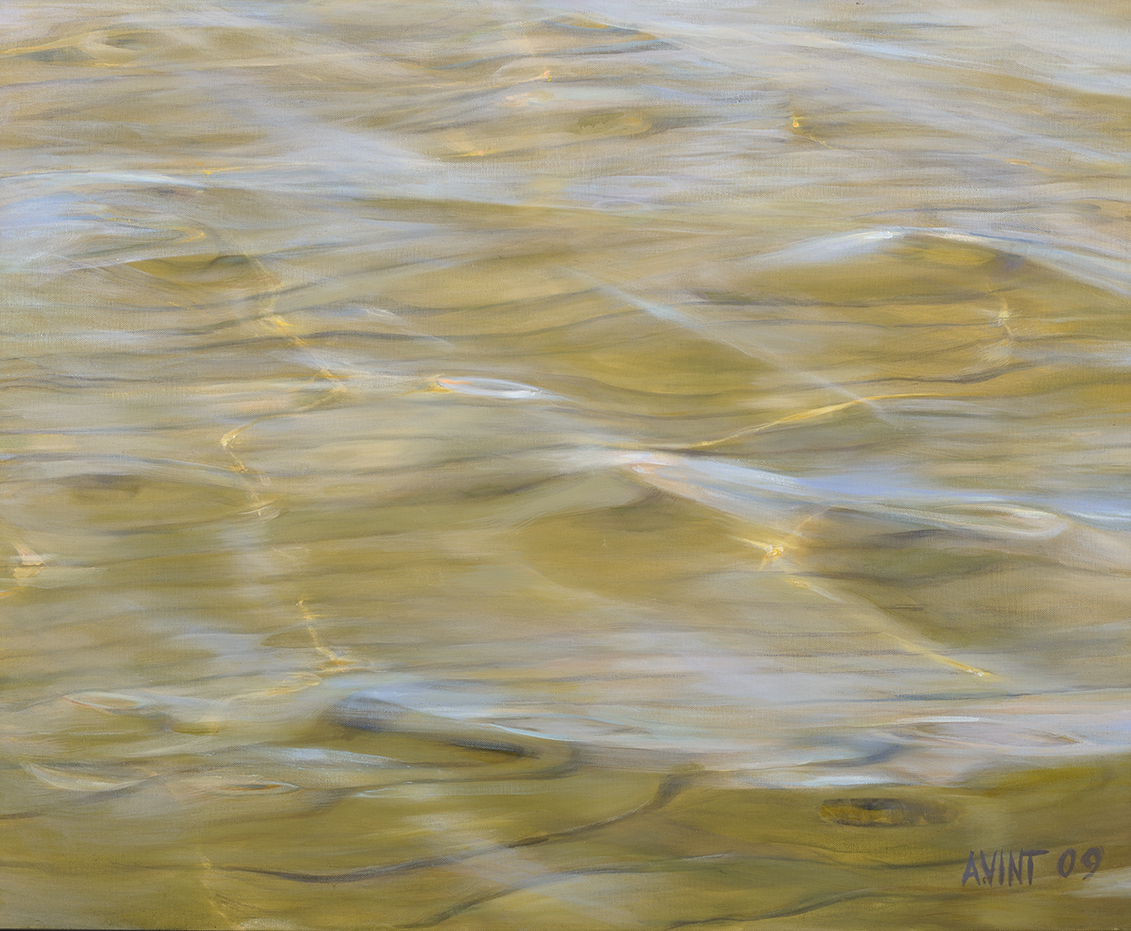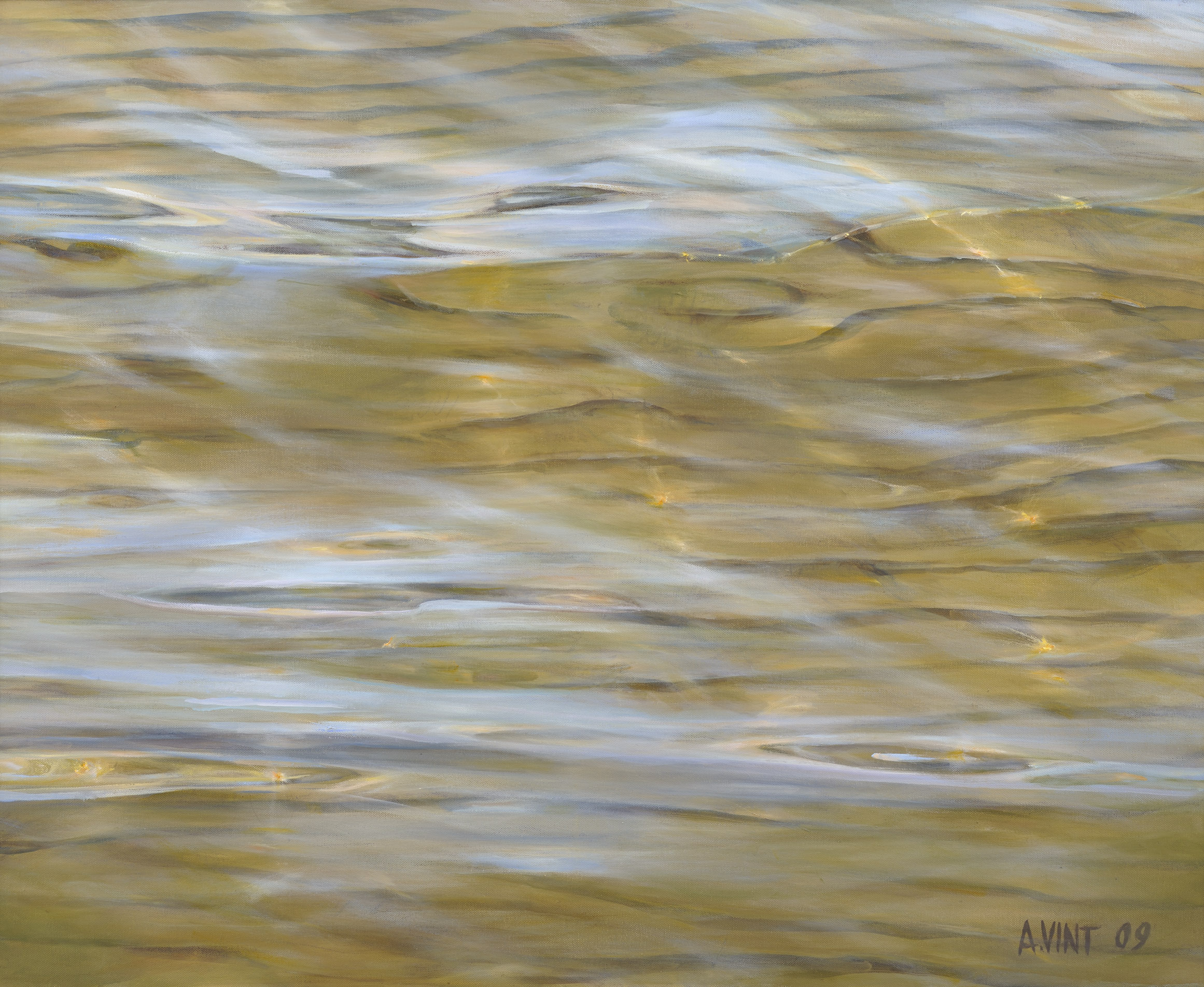Johannes Saar, Estonian Art Critic Aili Vinti on mere fenomenis paelunud tema jõud ja haaramatus – meri on kunstnikule tõeline väljakutse. Ning tulemuseks on omamoodi mere ideaal, kontsentreeritud sõnum võimsa loodusstiihia energias.
AILI WRESTLING THE SEA
„You become responsible, forever, for what you have tamed“, wrote A.Saint-Exupéri
Aili Vint: I enjoy painting the Quiet Sea, because painting a mirror-smooth surface is the most challenging and by far the hardest to do.– Have you tried to put the baby to bed, when he does not want to sleep? - In order to get the Sea to lie down on the canvas, you have to wrestle it for a long time. But one fine day I feel that now is the right time and then painting succeeds again with surprising ease – a if someone else was working inside me and making incredible things happen. As if the Sea itself was painting my Sea.— I am the Sea! — The Sea is painting me.
my marine paintings since 1972 —2014
SHALLOW SEA 1972 Oil on canvas,92 x 115 cm Tartu Art Museum
THE SEA 1974 Oil on canvas 115 x 144 cm, artist’s collection
THE SEA IN SPRING 1974 Oil on canvas 150 x 1170 cm, artist’s collection
REFLECTION OF CLOUDS 1986 Oil on canvas 115 X 92 cm, artist’s collection
SEA AT KÄSMU 1991 Oil on canvas, 150 x 175 cm artist’s collection
AFTER THE RAIN 1982 Oil on canvas, 100 x 115 cm private collection
By Aili Vint, from The Seabook
To me, the Stony Sea is the most important of my seascapes, because it was the source of a very poweful event. Once upon time, when I was painting stony and translucent water, I suddenly received shocking news that a young acquaintance of mine had taken her own life. While painting the picture, I remember wondering whether this profound angst I felt at the time would remain trapped in that picture.
Years later I received an answer. — A complete stranger came up to me, started scolding me for no longer painting the sea. Then she went on, searching for words: ”Your picture saved my life, you know…”She told me that she had wanted to end her life, to give herself to the sea. But a friend took her to the Kadriorg Art Museum to see one of my seascapes. The painting had mesmerized her, calling her back again and again. It offered her unaccountable consolation, until it finally calmed her down. This painting was The Stony Sea.
STONY SEA 1974 Oil on canvas, 115 x 135 cm, Kumu Art Museum
TRANSPARENT SEA II 2014 Oil on canvas, 110 x 190,5 cm, artist’s collection
TRANSPARENT SEA I 2014, Oil on canvas, 110 x 190,5 cm, artist’s collection
WET SEA 1986 - 1995 Oil on canvas 150 x 210 cm private collection
THE SEA WAS ONCE RED 2007 Oil on canvas 92 x 116 cm private collection
2019 “Border Poetics. Estonian Art 1918–2018” is an exhibition of the Art Museum of Estonia and the National Tretyakov Gallery, combining Estonian art of the last hundred years from the collections of the two museums.
1. THE ARCTIC OCEAN 1981 Oil on canvas 175 x 200 cm Tretjakov Gallery, Moskow
2. XXX BALTIC REGATTA. WAITING FOR THE WIND 1979 Triptychon II, oil on cancas 120 x 153 cm Tretjakovi Galley, Moskow
3. ON THE ISLAND OF TÜTARSAAR 1986 Oil on canvas, 115 x 145 cm Tretjakov Gallery, Moscow
LAZY SEA 1986, Oil on canvasl 100 x 115 cm private collection
STONE IN COASTAL WATER 2000 Oil on canvas 150 x 175 cm private collection
THE SEA-AFTER A STORM 1992 oil on canvas 115 x 150 cm artist’s collection
EVENING LAKE 1975 Oil on canvas 92 x 115 cm, private collection
… I asked forgiveness of the Sea
:I will never forget the sea the day after the sinking of the "Estonia". I was at our summer cottage, electricity was out, I did not know anything about what happened. The day after the storm, while walking on the seashore, I could not understand what had happened to the sea. It was frustrated and desperate, as if looking for something that could not be found. I had never seen such muddy colour, with too sharply and carelessly drawn lines. Just before sunset, when an enormous dark wall of clouds came and cast a heavy shadow over the sea, like a blanket, it seemed to calm down.
I heard about the catastrophe from our neighbours only the next evening. And then I knew that the sea was desperately seeking for forgiveness for taking too many lives at once.
A year later, riding to Pirita on the bus, I suddenly heard an old woman sigh to herself, "I hate the sea." and I felt that same pain again. I saw how she turned her back to the sea. But on this day the sea was so calm and placid. Beautiful and delicate. I got off the bus and asked forgiveness of the sea.
… …ma palusin merelt andeks
Mul ei lähe meelest meri pärast parvlaeva Estonia hukku Läänemerel 1994. aastal, teel Tallinnast Stockholmi.
Olime suvekodus, elektrit ei olnud, me ei teadnud õnnetusest midagi. Kui järgmisel päeval mere tormituju vaatama läksime, ei saanud ma aru, mis on merega juhtunud. Meri oli kui meeletu, üleni segamini ja sassis. Justkui otsiks midagi, mida ei leia ja on seetõttu ahastuses. Oigas ja ohkas kordamööda. Ta oli surmani väsinud, kuid ei suutnud kuidagi vaibuda.
Alles enne loojangut tuli suur tume pilvemüür ja tõmbas merele raske pilvepeegelduse nagu teki peale, ning meri rahunes veidi. Õhtul, naabertallu piima tooma minnes, saime teada, et meri piinles andekspalumise vaevas. Ta oli võtnud endasse korraga liiga palju elusid.
Mul oli valus, kui aasta hiljem, bussiga Pirita teel sõites kuulsin äkki ühte vana naist omaette vaikselt ohkamas:“Ma vihkan seda merd”, ja nägin, kuidas ta merele selja keeras. Aga meri oli sel päeval nii hele ja rahulik. Kaunis ja tasane. Malbe.
Läksin bussist välja ja palusin merelt andeks..
AFTER STORM 1984 Oil on canvas 92 x 115 cm, private collectio
REFLECTION OF DARK CLOUDS 1978 Oil on canvas 92 x 115 cm Tartu Art Museum, Estonia
SEA UNDER THE DARK SKY 1975 Oil on canvas 92 x 115 cm Kumu Art Museum, Estonia
SERENE SEA 1982 Oil on canvas 120 x 150 cm Tartu Art Museum, Estonia
PALE SEA 1975 Oil on canvas 92 x 115 cm, Kumu Art Museum, Estonia
my meditative installation concept is
Every year on September 2 8 th, in the countries that the victims where from, people bring flowers to the memorial. The moods cold and miserable. Our project will change all that.
We should find a public indoor space near the memorial, for example an exhibition hall or a museum, where every year on September 2 8 th the light would be turned off for the day. In the centre of the hall, a meditative light Installation can be designed in a form of A W H I T E C U B E or A H O L O G R A M .
1. WHITE CUBE
The light installation is in the form of a cube, as large as the exhibition space allows. When one first peeks in, the bright glow creates a moment of total white and you will see clean light at the end of the tunnel..This is where the time stops.
Existence in Timeless Space
“Existence in timeless space” works on the same principles as my other light sculptures. There is a large white cube in the middle of the room. The viewer can walk around it. In opposite walls of the cube there are openings. When you peek into the cube, the light glow creates a feeling of supreme emptiness, since all you see is the expanse of white wall. The space becomes an enormous vessel filled with the flow of daylight. The ‘white time’ captured in this space is as taut as a string on a violin. This is where the time stops yet the space seems to be void of time. Timeless
Stepping further in, one will find oneself suddenly immersed in magical sunset You will meet the eternity of Nature. A powerful storm of colours is all around, is in front of you and behind you, above you and below you. You can feel the warm touch of the sun and let the sea magically bring peace to your soul.
2. HOLOGRAM
Every year on September 2 8 th, when the memorial ceremonies take place in exhibition halls, only the lights are turned off and in the middle of the hall or on the big window the light hologram will shine.You step into the hall and feel the warm touch of the Sun, a secretive world of the Nature, where you can experience your very personal mental awareness of relaxation, revisiting past memories and meeting your subconscious mind.
The Sun teaches us all to wait, to be patient and to forgive.
GLITTER ON COASTAL WATER I 2009 Triptychon Oil on canvas 81 x 81 cm artist’s collection
GLITTER ON COASTAL WATER II 2009 Triptychon Oil on canvas 81 x 81 cm artist’s collection
GLITTER ON COASTAL WATER III 2009 Triptychon Oil on canvas 81 x 81 cm artist’s collection
COASTAL WAVE ON THE BLACK SEA 1983 Oil on canvas 100 x 173 cm artist’s collection
BLUE-BLUE SEA 2010 Oil on canvas 92 x 115 cm artist’s collection
BLACK SEA 1975 Oil on canvas 100 x 173 cm Zimmerliy Art Museum, USA
GLIMMERING WATER 2000 Oil on canvas 92 x 115 cm, artist’s collection
SUNSET FLASH 2011 Oil on canvas 110 x 191 cm, artist’s collection
ONE MORE SOURCE OF MY INSPIRATION
I will start with an extract from the book by Alessandro Baricco, “MARE OCEANO.”
“While ending up in a mysterious hotel at the seashore by chance, a professor is trying to determine where exactly the Sea ends…”
“The scientist is roaming around with his notebook and measuring tools, being unable to find resolution to the question he is researching - Where does the end of the Sea start? The perplexed professor is lamenting: “I am right here, within steps of the Sea, and I don’t understand where is Sea. Sea. - The Sea does not leave traces or give explanations….”
I, as a marine painter, especially enjoyed reading that book. I sincerely thank the gifted writer and answer with my painting: “My esteemed professor, I will show you where the Sea ends! — “Here!”
T H E S E A E N D S H E R E (dedicated to the Alessandro Baricco) 2007 Oil on canvas 110 x 190,5 cm artist’s collection
Aili Vint: I remember how I used to walk on the beach, pondering how to depict transparent water, how to paint those footprints that the steady rhythm of the sea left on the sandy sea floor. This is not possible, I concluded with sadness, but — You see!— Impossible things do not exist!
üks minu loomisallikatest
Uuesti hakkasin merd maalima, kui lugesin Alessandro Baricco romaani “Ookean meri”, kus kirjanik kirjutab maalimisprotsessi lahti nii: “Kunstnik rannal. Tõde! Kuid taas kord on kohal lunastav inimkübe, … too tähtsusetu olend liival, tibatilluke olend lõputu ranna täiuslikkuses. Eemalt vaadates on ta vaid must täpp, üks tühine inimene... ja kunstniku molbert. Mees uurib üksisilmi merd. Aeg-ajalt kastab ta pintsli vasktopsi ning tõmbab lõuendile mõned kerged viirud. Pintslikarvad jätavad endast maha kahvatuima varju, mille tuul otsekohe ära kuivatab, taastades endise kiiskava valge. Ja lõuendil pole mitte midagi. Mitte midagi, mida oleks võimalik silmaga näha. - Too mees maalib merd mereveega.”
Edasi kirjeldab Alessandro Baricco teadlast rannal: ”Juhuslikult salapärasesse mereäärsesse hotelli sattunud endine professor, kes püüab täpselt kindlaks teha, kus lõpeb meri.
“Ja meri ise, kes mässab professori visade püüdluste vastu temast aru saada.Teadlane uitab oma mõõteriistade ja märkmikuga ringi, leidmata algust otsitavale, juurdepääsu küsimusele: oma mõõteriistade ja märkmikuga ringi, leidmata algust otsitavale, juurdepääsu küsimusele: “Kus algab mere lõpp?“ Kimbatuses professor kurdab: „Olen siin, sammu kaugusel merest ja ei saa aru, kus ta on. Meri. Meri.“
Aili Vint: “Lugupeetud professor!
Ma näitan Teile, kus lõpeb meri — Siin!” Ma maalisin kahemeetrilisele lõuendile mereranna: “Siin lõpeb meri” 2007 ning pühendasin selle Alessandro Bariccole. Nii heledat merd pole ma enne maalinud, justkui oleksin ta maalinud mereveega.
continue:



